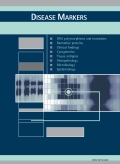Authors: Paone, Gregorino | Conti, Vittoria | Vestri, Annarita | Leone, Alvaro | Puglisi, Giovanni | Benassi, Fulvio | Brunetti, Giuseppe | Schmid, Giovanni | Cammarella, Ilio | Terzano, Claudio
Article Type:
Research Article
Abstract:
The pivotal role of neutrophils and macrophages in smoking-related lung inflammation and COPD development is well-established. We aimed to assess whether sputum concentrations of Human Neutrophil Peptides (HNP), Neutrophil Elastase (NE), Interleukin-8 (IL-8), and Metalloproteinase-9 (MMP-9), major products of neutrophils and macrophages, could be used to trace airway inflammation and progression towards pulmonary functional impairment characteristic of COPD. Forty-two symptomatic smokers and 42 COPD patients underwent pulmonary function tests; sputum samples were
…collected at enrolment, and 6 months after smoking cessation. HNP, NE, IL-8, MMP-9 levels were increased in individuals with COPD (p < 0.0001). HNP and NE concentrations were higher in patients with severe airways obstruction, as compared to patients with mild-to-moderate COPD (p =0.002). A negative correlation was observed between FEV_{1} and HNP, NE and IL-8 levels (p < 0.01), between FEV_{1} /FVC and HNP, NE and IL-8 levels (p< 0.01), and between NE enrolment levels and FEV_{1} decline after 2 years (p =0.04). ROC analysis, to discriminate symptomatic smokers and COPD patients, showed the following AUCs: for HNP 0.92; for NE 0.81; for IL-8 0.89; for MMP-9 0.81; for HNP, IL-8 and MMP-9 considered together 0.981. The data suggest that the measurement of sputum markers may have an important role in clinical practice for monitoring COPD.
Show more
Keywords: Airway inflammation, Chronic obstructive pulmonary disease, neutrophil elastase, human neutrophil peptides, interleukin-8, likelihood ratio, metalloproteinase-9, sputum, receiver operating characteristic analysis, smoking
DOI: 10.3233/DMA-2011-0807
Citation: Disease Markers,
vol. 31, no. 2, pp. 91-100, 2011
Price: EUR 27.50





